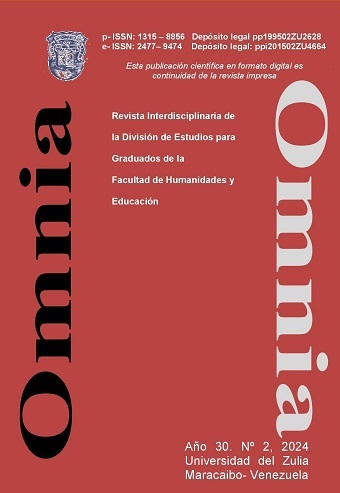Perception of the university teacher in the application of artificial intelligence in higher education
Abstract
The objective of the research is to analyze the Perception of the university professor in the application of Artificial Intelligence of the postgraduate professors of General Surgery at the Dr. Pedro García Clara Hospital. A descriptive methodology with a field design was used, consisting of a sample of 7 teachers. A questionnaire-type instrument was applied that included general data, the degree of knowledge, use, resources, empowerment and benefits of AI, in addition to its ad vantages and disadvantages. It was validated by 5 experts. The reliability was carried through the execution of a pilot test. Data analysis was done by statistical effects from the application of descriptive statistics. Among the main results, moderate management was obtained in 100% knowledge of AI, the y also recognize its use as simple, interesting, fun and allows monitoring in learning, for which the y recommend it. The tool al so empowers, provides security and is applicable as a virtual modality. The greatest advantage sits contribution to the quality y of learning. 100% refer to lack of resources for its application, as a major diced vantage. The reform, it was concluded: AI is a very important technology to obtain excellent valuable results in learning, the rebating a weakness such as the lack of resources, and it is recommended tore quest a conference to the Postgraduate Department of the General Surgery area of the institution to update technology referred to IA, Evaluate the computer infrastructure and determine the capacity of use.
Downloads
References
Ayuso-del Puerto, Desirée y Gutiérrez-Esteban, Prudencia (2022). La Inteligencia Artificial como Recurso Educativo durante la Forma-ción Inicial del Profesorado. RIED-Revista Iberoamericana de Educación a Distancia, 25(2), pp. 347-362. Disponible en: https://doi.org/10.5944-/ried.25.2.32332.
Calatrava, Carlos (2023). Análisis: ¿Cómo impacta la inteligencia arti-ficial en la educación universitaria en Venezuela? UCAB. Cara-cas. Disponible en: inanzasdigital.com/como-impacta-la-inteligencia-artificial-en-la-educacion-universitaria-en-venezuela/.
Calderón Ramírez, Jorge (1995). Calidad en el Aula. Una aspiración permanente. Calidad Integral. Guadalajara, Jal. México: Centro de Capacitación, S. C.
Clarke, Roger (2023). Congreso Mundial de Tecnologías de la Infor-mación. kaizen.es. Blog. Inteligencia Artificial: ventajas y desven-tajas. Disponible en: https://kaizennetworks.es/inteligencia-artificial-ventajas-y-desventajas/.
Dandeu, Juan (2023). Inteligencia artificial en Educación. Aire de Em-prender. Argentina. Disponible en:https://www.airedeemprender.com.ar/inteligencia-artificial-en-la-educacion/.
Díaz Tito, Luís., Tito Cárdenas, Julia., García Curo, Gianmarco y Boy Barreto, Ana (2021). Inteligencia artificial aplicada al sector edu-cativo. Revista Venezolana De Gerencia, 26 (96), 1189-1200. https://doi.org/10.52080/rvgluz.26.96.12.
Ezequiel Ander-Egg (2006). Metodologías de acción social. Editores: Jaén: Universidad de Jaén, España. 2006.
Fandos, Manuel (2003). Formación basada en las Tecnologías de la Información y Comunicación: Análisis didáctico del proceso de enseñanza-aprendizaje. Tesis doctoral. Disponible en: https://www.tdx-.cat/bitstream-/handle/10803/8909/-Etesis_1.pdf.
Hernández Roberto.; Fernández, Calos y Baptista, Ma Pilar (2014). Me-todología de la Investigación. Editorial Mc Graw Hill. Sexta edi-ción. México. P.601.
Kerin, Roger y Hartley Steven (2018). Marketing. 13 Edition. McGraw Hill-Inteamericana. Disponible en: https://bookshelf.vitalsource.com/-books/-9781456261962.
Londoño, Pablo (2023). Inteligencia artificial: qué es, cómo funciona e importancia. en. HubSpot. Disponible en: https://blog.hubspot.es/marketing/inteligencia-articial-esta- aquí#.
Pinos. Eduardo (2013). La educación universitaria: exigencias y desa-fíos. Alteridad. Revista de Educación ISSN No. 1390-325X. Vol. 8, No. 1, enero-junio 2013, 97-105.
Rentero, Antonio (2023). Las mejores herramientas de Inteligencia Artificial para la educación. Trecebits: Redes Sociales y Tecnolo-gía. Disponible en: https://www.trecebits.com/herramientas-inteligencia-artificial-educacion/.
Sabino, Carlos (1992). El proceso de la investigación. Editorial Paname-ricana. Bogotá. P. 216.
UNESCO (2021). Inteligencia Artificial y educación. Guía para las personas a cargo de formular políticas. UNESCO.
Vera Gualdrón, Luís (2005). Estrategias docentes con enfoque construc-tivista en el rendimiento académico de la Geografía de Venezuela en Educación Superior. Revista Venezolana de Ciencias Sociales UNERMB, Vol. 9 No. 2, 2005, 505 – 519. ISSN: 1316-4090.





